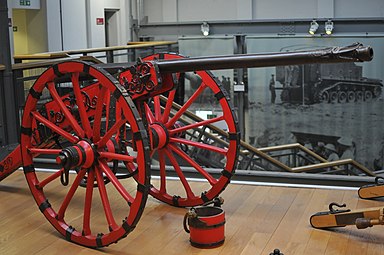Falconet (cannon)
This article needs additional citations for verification. (August 2017) |

The falconet was a light cannon developed in the late 15th century that fired a smaller shot than the similar falcon. During the Middle Ages guns were decorated with engravings of animals, such as reptiles, birds or mythical beasts depending on their size. For example, a culverin would often feature snakes, as the handles on the early cannons were often decorated to resemble serpents. The falconet fired small yet lethal shot of similar weight and size to a bird of prey, and so was decorated with a falcon. Similarly, the musket was associated with the sparrowhawk.[1]
| Part of a series on |
| Cannons |
|---|
 |
Its barrel was approximately 4 feet (1.2 m) long, had a calibre of 2 inches (5 cm)[2] and weighed 180 to 440 pounds (80 to 200 kg). The falconet used 0.5 pounds (225 g) of black powder to fire a 1 pound (450 g) round shot at a maximum range of approximately 5,000 feet (1,500 m).[3][4] They could also be used to fire grapeshot.
The falconet resembled an oversized matchlock musket with two wheels attached to improve mobility.[5] In 1620s Germany a breechloading version was invented, seeing action in the Thirty Years War.[6] Many falconets were in use during the English Civil War[4] as they were lighter and cheaper than the culverins, sakers and minions. During times of unrest, they were used by the nobility to defend their grand houses.[7]
Though developed for use on land, the falconet gained naval prominence during the 17th century for the defense of light vessels; for example, on small boats for boarding maneuvers.
Gallery
-
A barrel of a swivel gun falconete (c. 1476–1525). Material: Iron. Caliber: 65 mm.
-
Falconet in the Peasants War Museum Muehlhausen.
-
Wrought iron falconet, 17th century.
-
Breech-loading falconet in the Navy Museum of Lisbon, Portugal. Bronze. Reign of Sebastian I (1557–1578). Found in 1985 in the shipwreck of Portuguese carrack Santiago on the shallows of Judia, Indian Ocean.
-
Bronze falconet. Diameter: 11.2 cm (4 7/16 in.); Overall: 162.2 cm (63 7/8 in.); Bore: 4.7 cm (1 7/8 in.).
-
Falconet (1526); kartouwe (1617); kartouwe (1635); culverin (1681); rifle-barrelled cannon (1730); exhibition in the Spandau Citadel.
-
Breech-loading wrought iron falconet, 15th-16th century A.D.
See also
- Lela, Southeast Asian equivalent of falconet
- Culverin
- History of gunpowder
References
- ^ "History of the Scots Greys". Regimental-art.com. Archived from the original on 2015-04-17. Retrieved 2017-08-09.
- ^ "Falconet". Archived from the original on 2008-05-04. Retrieved 2008-08-26.
- ^ "Artillery through the ages". Nps.gov. Archived from the original on 2007-07-05. Retrieved 2017-08-09.
- ^ a b "Littlewoodham". Littlewoodham.org.uk. Retrieved 2017-08-09.
- ^ "Photographic image" (JPG). Farm1.static.flickr.com. Retrieved 2017-08-09.
- ^ [1] [dead link]
- ^ "Stephen Wood, Research and Consultancy in Military History". Archived from the original on 2008-07-24. Retrieved 2008-08-26.







